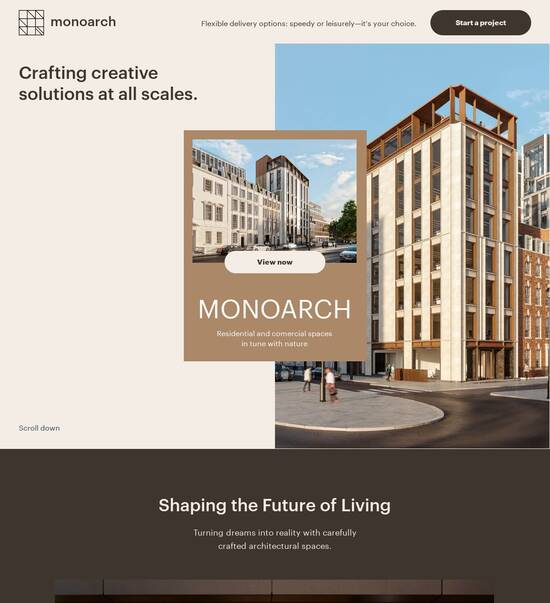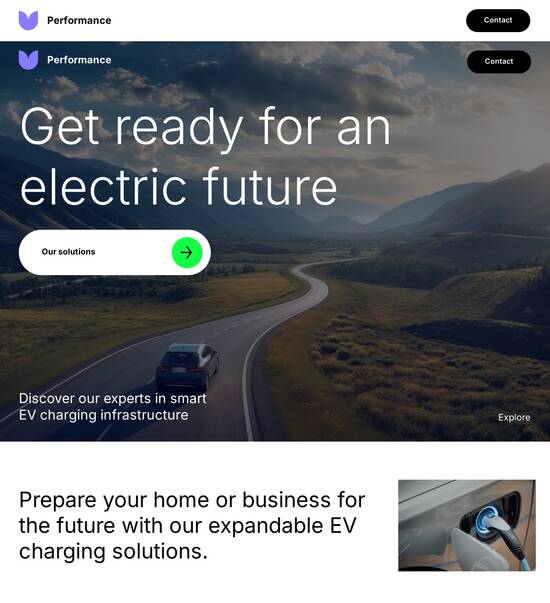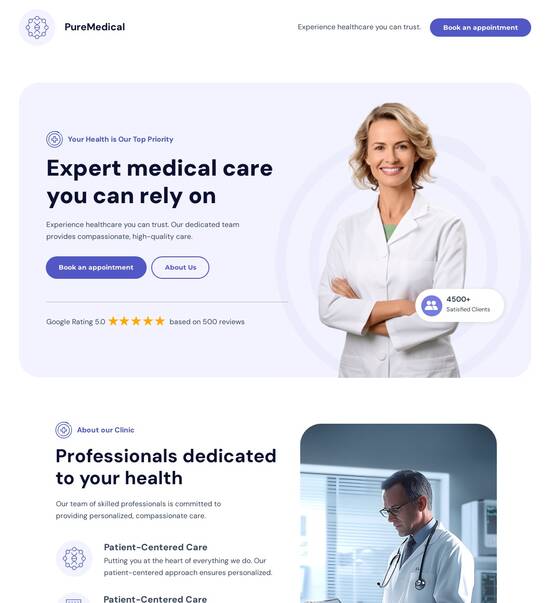
React.js optimized search results page template
Explore Similar TemplatesAbout template
Supercharge your search results page with React.js for outstanding performance! Learn more today.
Recommended templates

Easy to build without coding
With the intuitive drag-and-drop builder, anyone on your team can create high-converting pages without any knowledge of code or design. Make enhancements to your landing page with custom widgets using Javascript, HTML/CSS, or third-party scripts.

Multiple layouts for any industry and goal
Select from 500+ landing page layouts built to boost conversions across industry-specific scenarios. Customize them by adjusting fonts, adding images, and generating on-brand content with the AI assistant. Quickly scale with Instablocks® and Global Blocks that you can save, reuse, and update globally.

Loads fast and looks polished on any device
Every template is responsive, which means they present professionally on any device and load blazingly fast with our Thor Render Engine. You can also power them up with Google AMP technology to deliver an unparalleled mobile experience and drive higher conversions.

Robust analytics & experimentation
Get real-time updates and reporting across all your devices, showing the number of visitors, conversions, cost-per-visitor, and cost-per-lead. Launch AI-powered experiments, run A/B tests, and use heatmaps to analyze user behavior, then optimize your landing page to maximize conversions.







Easy to build without coding
With the intuitive drag-and-drop builder, anyone on your team can create high-converting pages without any knowledge of code or design. Make enhancements to your landing page with custom widgets using Javascript, HTML/CSS, or third-party scripts.
Multiple layouts for any industry and goal
Select from 500+ landing page layouts built to boost conversions across industry-specific scenarios. Customize them by adjusting fonts, adding images, and generating on-brand content with the AI assistant. Quickly scale with Instablocks® and Global Blocks that you can save, reuse, and update globally.
Loads fast and looks polished on any device
Every template is responsive, which means they present professionally on any device and load blazingly fast with our Thor Render Engine.
Robust analytics & experimentation
Get real-time updates and reporting across all your devices, showing the number of visitors, conversions, cost-per-visitor, and cost-per-lead. Launch AI-powered experiments, run A/B tests, and use heatmaps to analyze user behavior, then optimize your landing page to maximize conversions.
All the features you need to build search result templates with react js
Explore more featuresLearn how to build top-performing landing pages for any goal
FAQs
Leading the way in building high-performing landing pages





Maximize Your ROI with Instapage: The Powerful Landing Page and CRO Platform
Instapage stands out as a leading landing page and conversion rate optimization (CRO) platform, particularly for marketers in the USA looking to optimize their digital marketing campaigns. With its array of tools and features, Instapage empowers businesses across various sectors—such as marketing, technology, and education—to effectively boost their campaign performance.
Understanding the Importance of Landing Pages
Landing pages are critical for capturing leads and converting visitors into sales. A well-designed landing page can make the difference between a successful campaign and one that falls flat. By leveraging Instapage's robust features, you can create optimized landing pages that cater to specific audience segments and drive measurable results.
- High-converting templates: Instapage offers over 100 customizable templates that are proven to enhance conversion rates.
- Heatmap functionality: Gain insights into user behavior on your landing pages to identify areas for improvement.
- A/B testing: Regularly test different variations of your landing page to see which elements perform best.
Step 1: Accessing Instapage Templates and Lead Generation Tools
To kick off your landing page creation, start by choosing from Instapage's extensive library of templates. These ready-to-use designs are equipped with lead generation elements that help you capture information seamlessly.
Step 2: Building Your Landing Page Effortlessly
Instapage simplifies the page-building process without the need for coding. With intuitive builders and a library of conversion-focused layouts, you can create tailored landing pages for various campaigns.
- Use drag-and-drop features: Easily position elements on the page to create a visually appealing layout.
- Incorporate customization options: Adjust the design to match your brand identity effortlessly.
- Utilize Instablocks: Save and reuse sections across multiple pages for consistency and efficiency.
Step 3: Optimize for Conversion with Advanced Tools
To ensure your landing pages are performing at their peak, take advantage of Instapage's optimization tools. From in-depth analytics to personalization features, each aspect is designed to enhance user experience and boost conversion rates.
- Personalization: Use dynamic text replacement to tailor content for specific audience segments.
- Analytics dashboard: Monitor performance metrics in real-time to make informed decisions.
- Collaboration features: Streamline feedback and editing processes with your team and stakeholders.
With these steps, you can create high-converting landing pages that are strategically aligned with your marketing goals.
Start leveraging the power of Instapage today. Sign up now to transform your campaign results and achieve your ROI goals!
ReactJS optimized search results page template
Understanding the essentials of search results optimization in ReactJS
Building an optimized search results page is crucial for enhancing user experience and driving engagement. When working with ReactJS, it’s essential to harness its component-based architecture, which simplifies the process of creating and managing complex user interfaces. A well-structured ReactJS application can provide fast performance and responsiveness, which are key for query-driven content like search results.
The power of ReactJS in building dynamic search results pages
ReactJS stands out due to its component-based architecture, allowing developers to build reusable UI components, which drastically improves maintainability. Each component can manage its own state and lifecycle, making it easier to create interactive UIs without the complexity of traditional frameworks. Additionally, using React’s virtual DOM enhances performance by minimizing the number of updates to the actual DOM, leading to faster rendering times—a significant factor in search results pages where updates can be frequent.
State management plays a crucial role in keeping track of search results and user inputs. By utilizing libraries like Redux or MobX, developers can effectively manage global application state. Redux, for instance, provides a predictable state container which is beneficial in scenarios where search results need to be displayed, updated, or filtered based on various user actions.
Crafting efficient search filters for enhanced user experience
Effective search functionality often hinges on the types of filters implemented. Users typically expect to refine their search results based on different criteria. Text-based filters cater to users looking to specify their queries with precision, while location filters enable geo-targeted searches—extremely useful in applications involving services or products in specific locations. Moreover, categorical or tag-based filters help organize search results, providing a more intuitive user experience.
Text-based filters: Enable users to input specific queries.
Location filters: Enhance searches with geo-location technology.
Category and tag filters: Help users sift through large sets of results.
Implementing debouncing techniques can further optimize search performance. Debouncing limits the rate at which a function can fire, ensuring that search queries are only executed once the user has stopped typing for a predefined period. This not only improves the speed of search results but also reduces the load on backend servers.
Optimizing search result previews: Best practices
The presentation of search result previews significantly influences user engagement. Well-designed previews allow users to quickly assess the relevance of the results, facilitating faster decision-making. It's vital that these previews are visually appealing and well-organized, employing effective content layout strategies that break down information into digestible sections.
Responsive design ensures that search results pages display optimally across devices, from desktops to mobile phones. Utilizing lazy loading for images and content can significantly improve loading times and overall performance, especially when displaying large lists of search results.
Leveraging technologies for advanced search capabilities
Integrating APIs opens up a world of possibilities for enhancing search results. By connecting with third-party APIs, developers can enrich the search experience, offering users more dynamic and relevant results. For instance, a movie search application might utilize APIs from IMDb to fetch detailed information about films to display alongside search results.
API Integration: Streamline search results with dynamic data.
Natural Language Processing (NLP): Improve understanding of user queries.
Natural Language Processing is increasingly relevant for search functionalities. By incorporating NLP techniques, applications can better understand user queries, potentially leading to better quality search results and an enhanced user experience. Techniques like sentiment analysis and context recognition can help tailor responses based on the user's intent.
Community feedback and iteration: Building a search feature that works
User feedback is instrumental in refining search functionalities. Involving users in the development process through beta testing or pilot programs can uncover limitations and opportunities for improvement in the search feature. Engaging with the user community helps ensure that the search results meet the actual needs of the audience.
Gather feedback: Utilize surveys and interviews.
Pilot testing: Test features with real users.
Tools for collecting feedback such as heatmaps can be invaluable in understanding user interactions with search results. Analyzing this data can lead to actionable insights that help push further iterations of the search component.
Building teams around search optimization
Search optimization benefits greatly from interdisciplinary collaboration. Integrating skills from developers, designers, and product managers fosters a more comprehensive approach to functionality. Each functional area brings a different perspective, contributing to a more user-centric search feature.
User experience (UX) should be at the forefront of the search functionality design. Adopting agile methodologies empowers teams to respond quickly to user needs, ensuring that the search systems evolve alongside your audience's preferences.
Interdisciplinary collaboration: Leverage diverse expertise.
Agile methodologies: Enable rapid iteration and feedback.
Addressing common questions about ReactJS search capabilities
Maintaining optimal performance in search results queries require special techniques. Some common performance optimization strategies include ensuring minimal re-renders through shouldComponentUpdate lifecycle methods or using React.memo for functional components. These practices can prevent unnecessary updates and keep the user interface snappy and responsive, essential for an effective search experience.
Performance optimization: Use lifecycle methods effectively.
Caching strategies: Implement caching for frequent queries.
Building collective knowledge around search optimization
Developing a strong knowledge base around search optimization is crucial for advancing team skills. Comprehensive documentation and sharing resources can institutionalize understanding within the team. Furthermore, fostering an environment of continuous learning through cross-functional training supports the adoption of new techniques and tools.
Knowledge sharing: Create thorough documentation.
Cross-functional training: Engage team members in learning.
Defining the future of search in ReactJS applications
The future of search capabilities lies in staying ahead of technological trends. Innovations in machine learning and AI are already altering how search results are generated and classified. Understanding user behavior changes will also help anticipate future adjustments needed in search functionalities.
Emerging technologies: Monitor advancements in AI and ML.
User behavior predictions: Anticipate needs and changes.
Studying real-world applications provides valuable insights into successful search implementations. These case studies can highlight lessons learned and offer concrete metrics for evaluating performance.
Exploring the depth of search technologies
With a multitude of search technologies available, choosing the right tool is essential. Solutions such as Algolia and Elasticsearch offer varied features that cater to different types of search functionalities. Understanding the specific strengths and weaknesses of these technologies can assist in selecting one that suits your application's needs.
Comparison of search technologies: Assess features based on requirements.
Long-term strategies: Plan for scalability and manageability.
Ready to skyrocket conversions?
Supercharge your ad campaigns with high-performing landing pages
Get started














